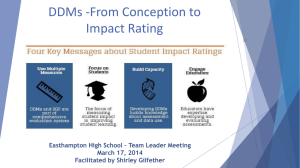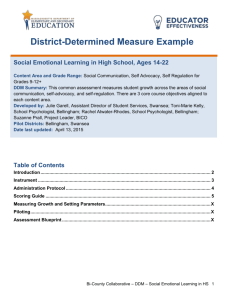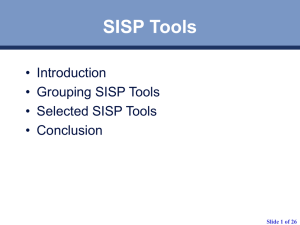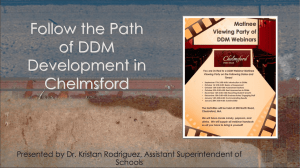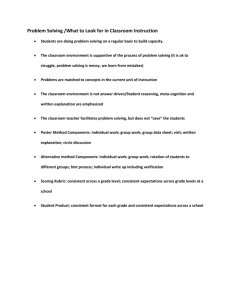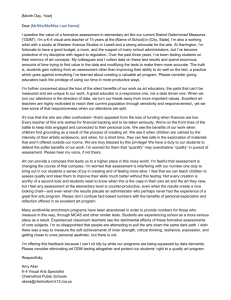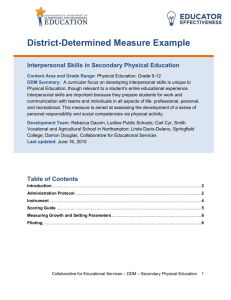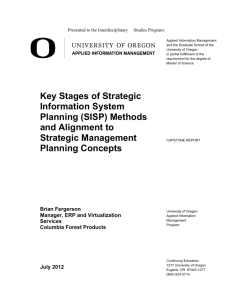Content Area and Grade Range: Social-Emotional Learning Skills, K-2
advertisement
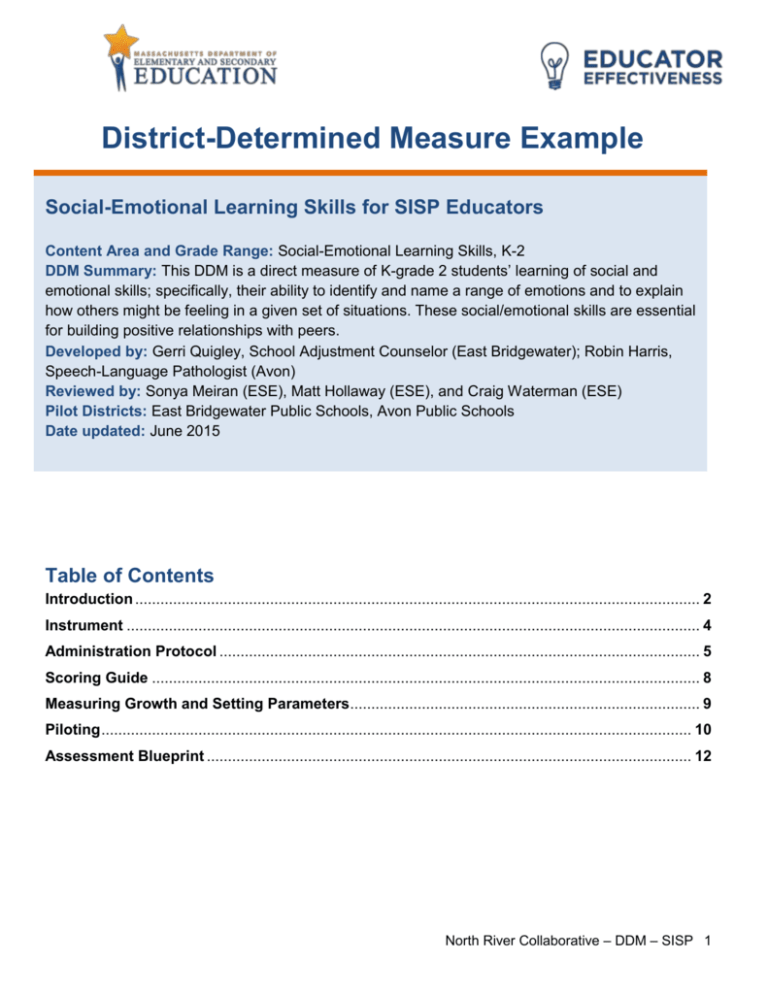
District-Determined Measure Example Social-Emotional Learning Skills for SISP Educators Content Area and Grade Range: Social-Emotional Learning Skills, K-2 DDM Summary: This DDM is a direct measure of K-grade 2 students’ learning of social and emotional skills; specifically, their ability to identify and name a range of emotions and to explain how others might be feeling in a given set of situations. These social/emotional skills are essential for building positive relationships with peers. Developed by: Gerri Quigley, School Adjustment Counselor (East Bridgewater); Robin Harris, Speech-Language Pathologist (Avon) Reviewed by: Sonya Meiran (ESE), Matt Hollaway (ESE), and Craig Waterman (ESE) Pilot Districts: East Bridgewater Public Schools, Avon Public Schools Date updated: June 2015 Table of Contents Introduction ...................................................................................................................................... 2 Instrument ........................................................................................................................................ 4 Administration Protocol .................................................................................................................. 5 Scoring Guide .................................................................................................................................. 8 Measuring Growth and Setting Parameters ................................................................................... 9 Piloting ............................................................................................................................................ 10 Assessment Blueprint ................................................................................................................... 12 North River Collaborative – DDM – SISP 1 Introduction Description & Rationale This DDM is a direct measure of Grades K–2 students’ learning of social and emotional skills. By SISP, we mean school counselors, social workers, speech pathologists, school psychologists, and related staff who work directly with students to develop their social and emotional skills. Specifically, this DDM is designed to measure growth in social awareness and interpersonal skills for maintaining positive relationships with peers. These skills are essential in school and life and require the ability to recognize the thoughts, feelings, and perspectives of others, including those different from one’s own. This measure, which consists of a set of pictured “feeling” and “scenario” cards and an Observation/Scoring Rubric, is based on professional observation of a student’s ability to identify and explain particular social-emotional skills in a one-to-one therapeutic setting. Socialemotional skills assessed by this DDM fall within the following two categories: (1) labeling pictured feelings, and (2) explaining the possible feelings and perspectives of others based on pictured scenarios (empathy). Target Audience Students participating in this assessment are those who have been identified by teachers, special education staff, and parents, or via the referral process of a Child Study Team as presenting with a weakness in social/emotional learning and/or language. The student must be on an IEP or 504 Accommodation plan, or being serviced by a school counselor or psychologist for the purpose of developing social emotional skills. This is necessary if this DDM is to reflect the effectiveness of the treatment being provided by the SISP. The minimum number of students for this DDM should be five in order to collect enough data to demonstrate growth in the area of social-emotional learning. The number of students should be limited to a maximum of 15 in order to effectively monitor and measure social-emotional growth throughout the year. If there are more than 15 students, other district SISPs who work directly with students on developing social-emotional learning may implement this DDM with the additional students. Since this measure looks at growth over the course of the school year, then students should be identified in September or very early in the school year. Students may be selected by first separating into grade levels if the SISP works with multiple grades, then choosing the first, third, fifth, etc. students from each grade until 15 have been chosen. Alignment This measure is aligned to the following Core Course Objective (CCO): Students demonstrate emotional regulation and expected verbal and non-verbal social/emotional communication skills in order to function in the school environment. A CCO is a statement that describes core, essential, or high priority content (knowledge, skills, or abilities), identified by those who designed the assessment, which is drawn, synthesized, or composed from a larger set of curriculum or professional standards. This CCO draws from Standard 5, Mental Health, from the MA Comprehensive Health Curriculum Framework, which states that by the end of grade 5, students will have acquired knowledge about emotions, management of emotions, personality and character development, and social awareness. They will also have North River Collaborative – DDM – SISP 2 learned skills to promote self-acceptance, make decisions, and cope with stress. This is a gradespan standard, meaning that it applies to students in K to grade 5. This content was selected for this DDM because elementary SISP staff often work directly with students who have been identified for services—they already show difficulty with the skills described in this standard and require sustained support for the development of appropriate social/emotional skills in the school context. This CCO and associated standards are also reflected in the Massachusetts Guidelines on Implementing Social and Emotional Learning Curricula. In addition, these standards are aligned with the professional responsibilities of school guidance counselors, as described by Specialized Instructional Support Personnel indicators I-A-1 and II-B-2. Content (Standard) Weight Students label pictured feelings. Mental Health Standard 5.1: By the end of grade 5, students Identify the various feelings that most people experience and describe the physical and emotional reactions of the body to intensive positive and negative feelings. (MA Comprehensive Health Curriculum Framework) 40% of the measure Students label the pictured feelings and perspective of others (empathy) and provide a plausible explanation. Mental Health Standard 5.1: By the end of grade 5, students Identify the various feelings that most people experience and describe the physical and emotional reactions of the body to intensive positive and negative feelings. (MA Comprehensive Health Curriculum Framework) 60% of the measure 100% Description of the DDM Development Process This DDM was developed during October 2014 – June 2015 under a DDM Leadership Grant (FC217) awarded to the North River Collaborative by the Massachusetts Department of Elementary and Secondary Education (ESE). In partnership with the Learning Innovations Program at WestEd (Woburn, MA), the Collaborative convened 12 staff from the Collaborative’s member districts, including PK-12 school guidance counselors, adjustment counselors, school psychologists, and school social workers, as well as speech, language and hearing specialists. Participants worked in small teams to strengthen and apply their assessment literacy toward the development of four direct and indirect measures of student growth related to students’ social/emotional development. Participants grew their expertise over seven sessions by engaging in a guided DDM development process framed by a series of questions, including: 1. What is most important to measure? North River Collaborative – DDM – SISP 3 2. 3. 4. 5. 6. How shall we measure what’s most important? How can we strengthen and refine our measure? How can we prepare our measure for broader use? What do we want to gain from the pilot? What did we learn from the pilot? Throughout, participants engaged in large group discussion and critique, as well as team collaboration and problem solving. In addition to refinements made during these sessions, each measure was also strengthened based on feedback from an ESE review team. Measures were then piloted from April-June 2015. Finally, the group analyzed data collected during the pilot phase, which informed final revisions, as described in the closing pages of this document. Next Steps Districts in and beyond the Collaborative now have the opportunity to decide if they would like to implement or modify the attached assessment for use as a DDM for Specialized Instructional Support Personnel (SISP). Because this is a newly developed measure, it is important that districts engage SISP, including school counselors, social workers, speech-language pathologists, and school psychologists, as well as related staff, in examining results from the first year of implementation. Over time, staff should identify any revisions or refinements that may further strengthen the quality of the assessment, scoring tools, administration protocol, and/or growth parameters to suit the circumstances and realities of the district’s local context. Instrument The Instrument consists of a one-to-one student assessment and scoring rubric where the SISP evaluates students’ responses in two areas – labeling pictures and labeling the feelings and perspectives of others. To accomplish this, the counselor uses a pre-determined set of feeling and situation cards, as described below. Sources for Feeling and Situation Cards Feeling and Situation Cards are available from the following sources: Committee For Children, SECOND STEP, K–2 Kits (www.cfchildren.org/second-step.aspx) May be ordered through Amazon.com Webber Photo Cards “Emotions” by Super Duper Publication Photo Feelings by Fun Deck Cards Photographic Learning Cards Facial Expression by Motivation USA Carson Dellosa Key Education Facial Expression Learning Cards by Carson Dellosa Language Cards “Photos & Words for Developing Oral & Written” Skills by North Star After purchase, districts must identify the same set of eight Feeling and Situation Cards that align with the descriptors provided in this DDM for use by all district SISP. Alternatively, a district could opt to identify eight different emotions and modify the Observation/Scoring Rubric to align with the preferred set of cards. North River Collaborative – DDM – SISP 4 Set 1: Happy, sad, surprised, scared, proud, silly, angry, disgusted Set 2: Eight additional situation cards showing nonverbal clues of a person’s feelings with these same emotions Interpreting the Feeling and Situation Cards The terms defined/identified by the product developer or manufacturer should be used in determining correct responses. In instances where the developer has not identified correct or allowable responses, the SISP team should determine correct/allowable responses prior to administration; all SISP using the assessment must then adhere to the agreed upon correct responses. In each pictured scenario, the team must identify the person who displays the targeted feeling before administering the DDM. They must also point to that person when they administer that portion of the DDM to the student. It is strongly recommended that the SISP team co-construct a chart showing the picture cards and acceptable responses for each card as a guide to strengthen the consistency of scoring across the team. For example, the team may decide that student responses that are close synonyms for the pictured emotion—such as “mad” for “angry”—are scored as correct. This chart should be modified following the first assessments to reflect the kinds of responses students actually provided and to increase consistency in how SISP professionals score students’ varied responses. The Observation/Scoring Rubric The student’s name, grade, and the observation date should be noted at the top of the provided Observation/Scoring Rubric. This rubric describes two social-emotional skill categories, listed down the first, left-hand column of the chart: I. II. Identifying/Labeling Pictured Feelings Labeling the Feelings and Perspective of Others from pictured scenario cards The top row of the rubric describes several performance levels based on the number of correct responses provided by the student. A point value is noted in each cell of the rubric. These scores align with the weighting represented in the Assessment Blueprint. During the assessment, the counselor records the student’s responses, and then circles the point value that is associated with the student’s observed level of performance for each skill within a targeted skill category. Administration Protocol The Administration Protocol addresses how the measure is intended to be implemented to best support a common conversation about student growth across classrooms. When is the measure administered? Administration occurs during three intervals in the school year: October, January, and May. During each observation period, the SISP professional conducts the assessments in a one-to-one therapeutic setting. The same SISP must administer the assessments throughout the school year. If there is a change in staff and the district wishes to allow the new SISP to use data collected from a North River Collaborative – DDM – SISP 5 prior administrator for use as a baseline, the data for the impact of this SISP on growth would need to be examined with caution. Because this is a repeated measure, the same assessment, materials, and procedures are used each time the measure is administered. The SISP may administer Sections I and II in two separate sessions if necessary due to time constraints. Each of these sessions, however, must take place no more than one week apart. Each assessment will require a 20-30 minute session. If administered in two sessions, all of Section I should be administered in the first session and all of Section II in the second session. How is the measure administered? SISP professionals prepare for observations and subsequent scoring by doing the following: 1) Review the Observation/Scoring Rubric and related administration directions. 2) Prepare copies of the Observation/Scoring Rubric for each student, noting each student’s name and grade at the top of each sheet. 3) Write the correct response on the Observation Scoring Rubric. Prompts should also be included on the scoring rubric to ensure consistency in DDM administration. 4) SISP professionals are strongly encouraged to coordinate calibration sessions with colleagues, as described in the Scoring Guidance section, below. The Observation Rubric includes two categories: (I) Labeling Pictured Feelings, and (II) Labeling the Feelings and Perspectives of Others (empathy). Section I: Labeling Pictured Feelings This section involves the use of the first set of cards picturing people’s feelings. The same picture cards are used throughout the year. (See above for a source listing for these cards.) The SISP professional shows the pictures and says to the student each time, “Tell me how this person feels.” No additional cueing, suggestive voice inflection, or words of enticement or coaching are permitted. If the student does not respond or responds, “I don’t know,” the prompt may be repeated once. If the student still does not respond or responds, “I don’t know” again, the score is 0 (zero). The SISP professional attends to the student’s ability to recognize and name the pictured emotions and records the student’s response for each card in the space provided. After the eighth card, the SISP circles the point value associated with the demonstrated level of the student’s performance on the provided Observation/Scoring Rubric. Section II: Labeling the Feelings and Perspectives of Others (empathy) The SISP professional then shows the second set of eight situational picture cards and prompts the student by saying, “Tell me how this person feels” and “Why does he/she feel that way?” For example, when showing a picture of boy crying at a lunch table, a student might respond, “He feels sad because he left his lunch at home,” or “The boy feels sad because the teacher told him he has to eat something he doesn’t like.” Both responses correctly identify the feeling and provide a plausible explanation that links back to the feeling. A response such as, “He is mad. He is sitting all alone,” does not identify the correct feeling and does not clearly link the explanation back to the feeling, i.e., why would sitting alone make someone feel mad? North River Collaborative – DDM – SISP 6 The SISP professional must be careful to wait for the student’s response without providing any extra prompts or support. If the student does not respond or responds, “I don’t know,” the prompt may be repeated once. If the student still does not respond or responds, “I don’t know” again, the score is 0. The SISP professional attends to the student’s ability to accurately name how another child may be feeling and whether the student can provide a plausible explanation for what might have caused the pictured child to feel this way. The SISP professional then records the student’s response and explanation and circles the point value associated with the student’s demonstrated level of performance using the provided Observation/Scoring Rubric. The SISP professional may conduct this assessment only once per period (October, January, and May) and must never provide or suggest the correct answers or give any other feedback to the student on the correctness of his or her responses. The SISP professional may provide general positive comments at the end of the assessment, such as, “Nice work today,” but may not provide specific feedback on the student’s interpretation of the picture cards. This would essentially contribute to teaching the child the correct responses and skewing subsequent results. Calibration It is suggested that SISPs calibrate their student observation and scoring with others using the DDM in their school or district. Calibration strengthens the likelihood that observations and scoring will be conducted in a consistent and reliable manner over time and across users. A sample calibration protocol can be found at the Rhode Island Department of Education website: http://www.ride.ri.gov/Portals/0/Uploads/Documents/Teachers-and-Administrators-Excellent-Educators/EducatorEvaluation/Online-Modules/Calibration_Protocol_for_Scoring_Student_Work.pdf . This protocol can be modified for use with this DDM in a couple of ways. First, a calibration exercise can be completed by participants scoring 1-3 videotaped samples of student performances, assuming all district policies about video-taping students are followed. Alternatively, participants can conduct joint observations where two SISP professionals observe the same child at the same time. They can discuss their scoring afterward and resolve scoring discrepancies by clarifying and coming to agreement about what the scoring criteria mean in relation to students’ observed performances. How will accommodations be documented? The use of visual picture cards in Sections I and II of this assessment is intended to facilitate access to the social/emotional content for all students, including students with language disabilities and English language learners. No specific further accommodations are needed for students with disabilities unless specified in a student’s Individualized Education or 504 Plan. It is important to consider any language or cultural issues that may affect the results of this assessment. First language translation may be provided for any English language learner who is in the first tier of language development. This translation may be provided by a district staff member (ELL teacher) or other translator as designated by the student’s school district. The translator is not responsible, however, for administering the assessment and must be accompanied by the SISP professional. For English language learners, some explanations of why those pictured on the cards may feel particular emotions that reflect cultural norms or experiences from their own or their North River Collaborative – DDM – SISP 7 family’s home country or cultural community. Therefore, the SISP should seek input from the ELL specialist or coordinator in interpreting the responses of these students. All provided accommodations must be recorded on the Observation/Scoring Rubric. Scoring Guide Who Should Score the Assessment? The SISP professional conducts all observations and scores the assessment; this person has the relevant professional knowledge to interpret students’ demonstration of the social-emotional skills evaluated in this assessment. It is strongly recommended that SISPs calibrate their scoring with role-alike colleagues in their school or in other schools in the district. Calibration strengthens the likelihood that observations and scoring will be conducted in a consistent and reliable manner over time and across sites. (See sample calibration protocol, above, in Administration Protocol section.) How Should Assessment Scores Be Calculated? The Observation/Scoring Record for students in grades K-2 provides a template for the SISP professional to use during the scoring process. The SISP professional transfers total scores from the Observation/Scoring Rubric to the Student Scoring Record following each administration of the assessment, then compiles and calculates gain scores at mid-year and year-end using the following steps: 1. Record the student name and grade at the top of the Student Scoring Record. 2. Locate the appropriate benchmark period along the top of the form and record the administration date. 3. Going down that benchmark column, record the TOTAL points earned for the student’s demonstration of skills for the two sections of the assessment. If the two sections were administered on two different dates, record the second date of administration in the provided space. 4. At the bottom of the row, record the total number of points earned during this benchmark period. This will be some number out of a total possible 100 points (_____ / 100). 5. After the first and second benchmark assessments have been administered, look across the scores in each relevant section and determine the difference between the two benchmarks. For example, if October’s benchmark for Section I: Labeling Feelings was 20 points and January’s benchmark was 30 points, the difference represents a gain of 10 points. Repeat the same procedure with Section II: Labeling Pictured Feelings & Perspective of Others (empathy). Then look down the Gain column and record how much total gain the student has achieved by mid-year. This information should help the SISP modify his or her instructional focus or strategies in order to help the student achieve moderate or high growth by year’s end. North River Collaborative – DDM – SISP 8 6. To calculate the overall gain in points in May, look down the far right column on the Student Score Report and add the gain points for the two social-emotional skill sections (representing gains from October to May). For example, if a student showed a 30-point gain in one section and a 20-point gain in the second section, overall, this would represent a 50-point gain over the course of the school year. 7. It is important to note that this overall gain score may mask a lack of gains in either social- emotional skill category. For example, it is possible that a student might actually demonstrate a loss of skill in Section I of the assessment, represented perhaps by negative numbers. Perhaps the student showed 20/40 points on the first benchmark and 10/40 on the second benchmark, representing a loss of 10 points, or -10. Therefore, it is essential that the SISP professional track gains at the skill category level along the horizontal row on the Student Score Record and that instructional strategies and supports be adjusted appropriately during the year. Measuring Growth and Setting Parameters The assessment activities in this DDM closely match the types of activities that SISP professionals conduct in the therapeutic setting to help young students strengthen and reflect on their social/emotional skills. As a repeated measure that gauges students’ progress from October to January to May, this assessment also has the advantage of being relatively brief and integrated into the curriculum, which is a useful option for young students. (See ESE’s Technical Guide B, page 12.) It also provides teachers with several cycles of feedback so they can modify their instructional supports in response to students’ performance. Grades K-2 students may be working on social/emotional skills at different developmental levels and may experience different social/emotional challenges, sometimes related to identified learning disabilities. We expect most of those working individually with SISP professionals to gain 30-60 points in a year’s time, representing moderate growth. As shown in the Student Growth Parameters table below, a gain of fewer than 30 points represents low growth, and a gain of more than 60 points represents high growth. These growth parameters represent estimated parameters that should be examined and revised, as necessary, after collecting data for a full school year. Table 1: Student Growth Parameters Total (Year-End) Gains Low Growth Moderate Growth High Growth < 30 point gain 30-60 point gain > 60 point gain North River Collaborative – DDM – SISP 9 Piloting This assessment received multiple peer and expert reviews during initial development. For example, staff at WestEd (Woburn, MA) critiqued the assessment task and associated scoring materials, which contributed to rethinking the Student Scoring Record and growth parameters. An ESE review team also provided critical feedback, which led to the simplification of the overall assessment, since the original design really amounted to two DDMs rolled into one. Finally, a two-month preliminary pilot of the assessment in the developers’ own schools and districts contributed to the development of increasingly specific, feasible, and informative tools for potential users. Our DDM was piloted by East Bridgewater Public Schools, East Bridgewater, MA, and Avon Public Schools, Avon, MA during the months of April and May, 2015. Our sample for the pilot included 11 from Kindergarten, 4 from Grade 1, and 5 from Grade 2, for a total of 20 students. The three questions we set out to answer in the pilot and our data collection strategies were: Question 1: How clear and complete are each of the sections of the DDM to SISP professionals who were not part of the development process? Question 2: Is the assessment feasible? Can we realistically assess students’ social/emotional skills in the manner we have designed (in the first administration)? Question 3: What scores do K-2 students achieve on the scoring rubric in late May? Pilot Results We analyzed the data to identify overall strengths of our DDM, as well as concerns or issues that indicated a need for DDM revisions. For Question 1 we conducted cognitive interviews to learn how the users who were not part of the development team understood the full text of the DDM. We learned the following: The DDM is, overall, clearly written and easy to understand. The student may be referred by a teacher, Child Study Team in the district, and/or a parent addressing concerns about their child’s social emotional learning, with or without a diagnosis. The student must be on an IEP or 504 Accommodation plan or receive services from a school counselor or psychologist for the purpose of developing social emotional skills. This is necessary if this DDM is to reflect the effectiveness of the treatment being provided by the SISP. The correct response should be written on the Observation Scoring Rubric for ease of scoring. Prompts should be included on the scoring rubric to ensure consistency in DDM administration. For Question 2 we collected participant feedback from those who administered the DDM to learn whether they felt the administration and scoring protocols were clear and feasible. We learned the following: The prompt for labeling feelings should be the same for skills in Sections I and II (“Tell me how this person feels”). The prompt for providing a plausible explanation for the pictured North River Collaborative – DDM – SISP 10 feelings (Section II) should be changed to “Why does he/she feel that way?” – the prompt “What happened” does not clearly link back to the feeling pictured in the situation. If the student does not respond or responds, “I don’t know,” the prompt may be repeated once. If the student still does not respond or responds, “I don’t know” again, the score is zero. It may not always be clear which person in the pictured scenario is the person who displays the targeted feeling. The team must identify that person in each pictured scenario before administering the DDM. They must also point to that person when they administer that portion of the DDM. For Question 3 we administered the assessment twice (once in mid-April and once in late May) and compiled scores for each student who participated. We learned the following: Three of the pictured feelings were problematic for the majority of the students— disappointed, worried, frustrated—and were frequently mislabeled, earning zero points. These emotions are not as easily differentiated in photographs for early elementary schoolaged students. Additionally, most of the pictured feelings were negative. Revisions have been made: (a) to provide pictured feelings that are more clearly expressed and distinguished from other feelings, and (b) to provide a better balance of positive and negative feelings. Disappointed, worried, and frustrated have been replaced with proud, silly, and disgusted. It was determined that the first administration should be conducted in October, rather than September, in order to provide enough time at the beginning of the school year to identify students with social-emotional learning challenges. There was no discrepancy in scores of students on IEPs versus students not on IEPs. This data confirms that students not identified with a disability may also need support with socialemotional learning. Due to the short period of time between the administrations of the DDM pilot, the data collected is not an accurate measure of student growth in social-emotional learning skills. In order to be able to document end-of-year gains, only students who begin school in September and are enrolled for the entire school year will be participants in this DDM. We originally estimated our growth parameters for what we would expect for student growth over the course of a school year. Our pilot, however, only occurred at the end of the school year (April and May). Average overall growth was +8 points for the one-month pilot, with a median of +10 points. It will be important for any school district that adopts or modifies this DDM to collect its own student data for the entire school year, then further examine whether these growth parameters are appropriate. North River Collaborative – DDM – SISP 11 DDM Pilot Data: Social/Emotional Learning Grades K–2 I. Label Pictured Feelings Student ID 1 2 3 4 5 6 7 8 9 10 11 12 13 14 15 16 17 18 19 20 Mean Score II. Label Pictured Feelings & Perspective of Others Overall Scores Total Total Total Late Late Late Late April May Gain Grade April May Gains April May Gains Score Score Score K 20 20 0 20 35 15 40 55 15 K 10 20 10 10 10 0 20 30 10 K 20 30 10 20 20 0 40 50 10 K 20 20 0 45 50 5 65 70 5 K 20 20 0 30 30 0 50 50 0 K 10 20 10 15 30 15 25 50 25 K 5 5 0 20 40 20 25 45 20 K 5 20 15 10 20 10 15 40 25 K 20 20 0 20 10 -10 40 30 -10 K 20 10 -10 10 30 20 30 40 10 K 20 20 0 15 20 5 35 40 5 1 10 10 0 20 20 0 30 30 0 1 30 30 0 35 35 0 65 65 0 1 20 10 -10 30 25 -5 50 35 -15 1 20 20 0 20 20 0 40 40 0 2 20 30 10 20 30 10 40 60 20 2 10 15 5 10 15 5 20 30 10 2 20 30 10 20 30 10 40 60 20 2 20 20 0 25 35 10 45 55 10 2 20 20 0 30 30 0 50 50 0 17.00 19.50 2.50 21.25 26.75 5.50 38.25 46.25 8.00 North River Collaborative – DDM – SISP 12 Observation/Scoring Rubric for K – Grade 2 Student Name: __________________________________ Grade: _____________ Date: ______________________ Directions: Conduct the assessment in a one-to-one setting. Record the student’s responses in the space provided, then circle the point value associated with the observed level of performance for each targeted skill. PROMPT: Tell me how this person feels. Targeted Skill I. Label Pictured Feeling Cards Not Yet Demonstrating Student needs full support/no independence Emerging Student needs substantial support Developing Student needs occasional support Strengthening Student has solid understanding and needs minimal or no support Mentoring Student needs no support and is able to support or coach peers with this skill Identified 0-1 cards Identified 2-3 cards Identified 4-5 cards Identified 6-7 cards Identified all 8 cards 0 ⏮ not applicable 10 20 30 40 Correctly label 8 pictured facial expressions: happy, sad, surprised, scared, proud, silly, angry, disgusted. Correct Response Student Response Correct Response Student Response 1. happy 1. 5. proud 5. 2. sad 2. 6. silly 6. 3. surprised 3. 7. angry 7. 4. scared 4. 8. disgusted 8. North River Collaborative – DDM – SISP 14 PROMPT: 1) Tell me how this person feels. 2) Why does he/she feel that way? II. Label the feelings & perspective of others (empathy) from pictured scenario cards Identified 0-1 cards Identified 2-3 cards Identified 4-5cards Identified 6-7 cards Identified all 8 cards Correctly label the feelings of a person in eight pictured scenarios as happy, sad, surprised, scared, proud, silly, angry, disgusted 0 5 15 20 30 Provide plausible explanation for why the eight pictured people in the scenarios might feel happy, sad, surprised, scared, proud, silly, angry, disgusted 0 5 15 20 30 Correct Response 1. Record student’s responses below: Feeling: Explanation: 2. Feeling: Explanation: 3. Feeling: Explanation: 4. Feeling: Explanation: 5. Feeling: Explanation: 6. Feeling: Explanation: 7. Feeling: Explanation: 8. Feeling: Explanation: Accommodations Provided and Rationale for Providing: North River Collaborative – DDM – SISP 15 Student Scoring Record Student Name: ______________________________________________ Administration Date Grade: ___________ 1st Benchmark Period (October) 2nd Benchmark Period (January) 3rd Benchmark Period (May) insert date insert date insert date I. LABEL PICTURED FEELINGS /40 Administration Date insert date II. LABEL PICTURED FEELINGS & PERSPECTIVE OF OTHERS (empathy) /40 /40 insert date insert date /60 /60 /60 /100 Total Score /100 Total Score /100 Total Score GAINS 2nd Benchmark ̶ 1st Benchmark GAINS 3rd Benchmark ̶ 1st Benchmark GAINS by mid-year GAINS by year-end Estimated Student Growth Parameters End-of-Year Gains Low Growth Medium Growth High Growth < 30 point gain 30-60 point gain > 60 point gain North River Collaborative – DDM – SISP 16
